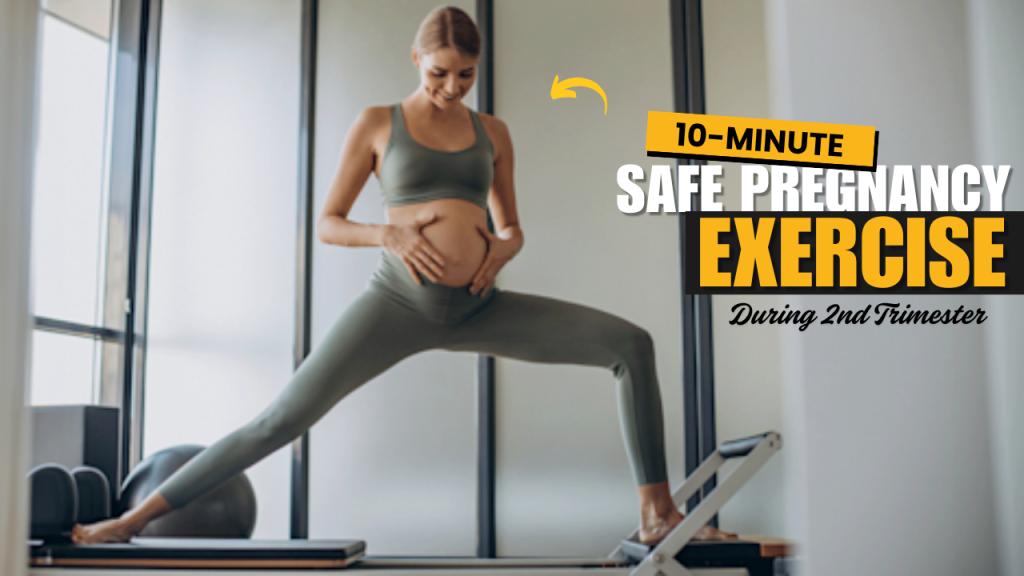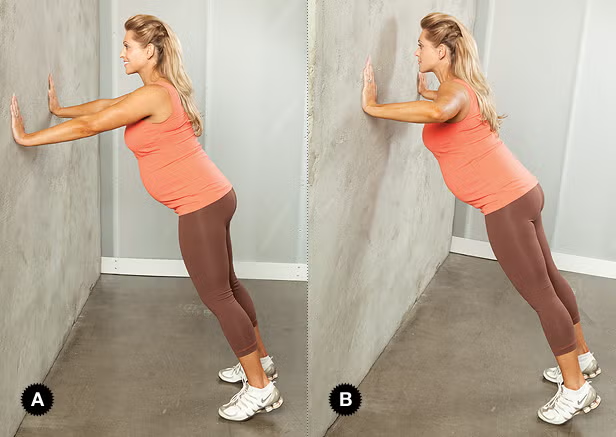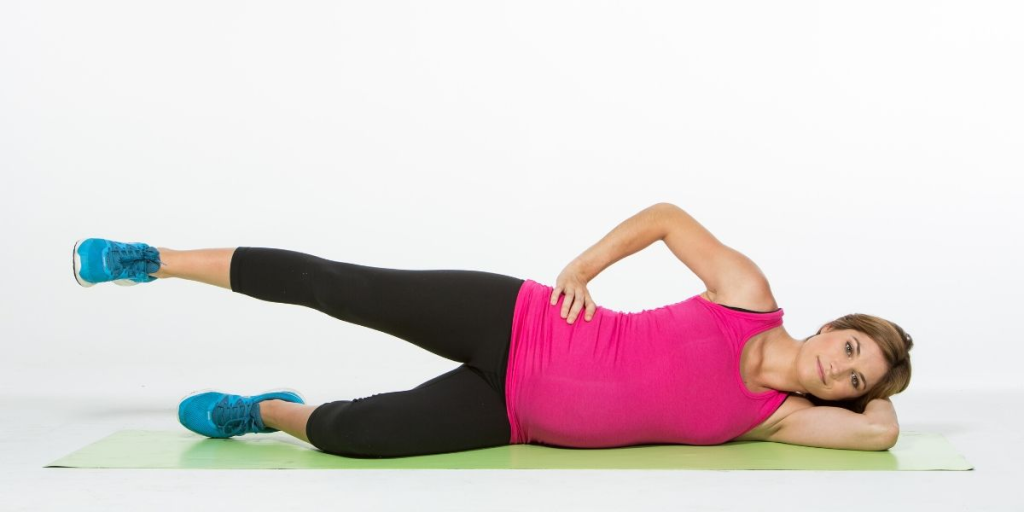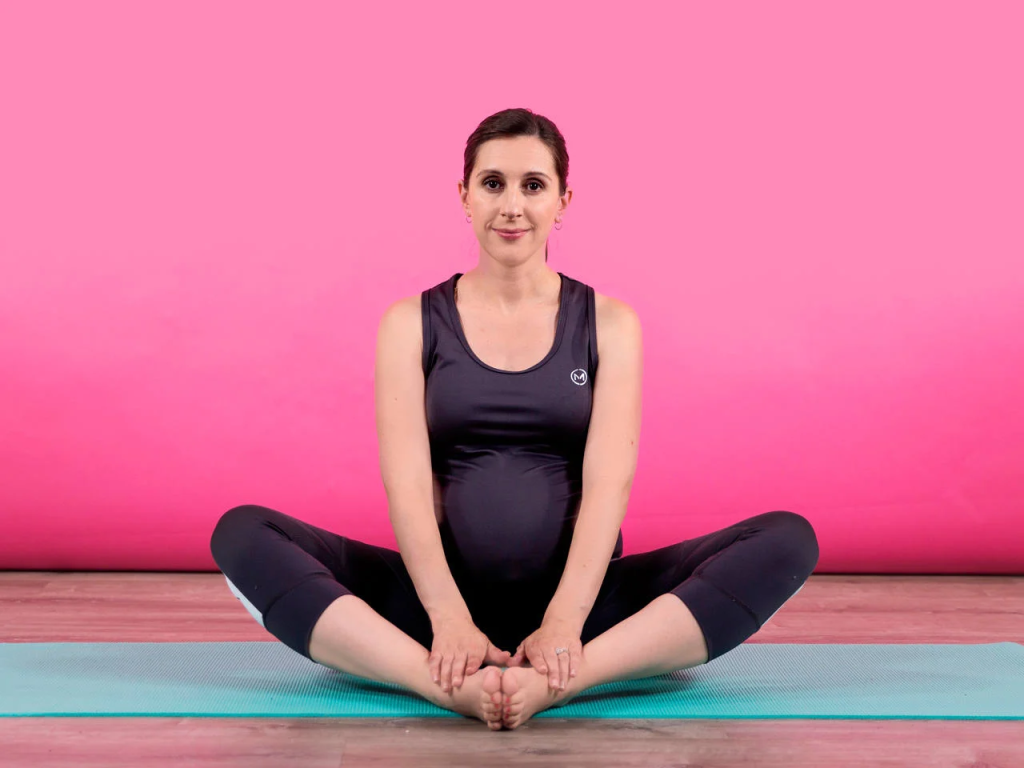Do you know that staying active during pregnancy not only helps with smoother labor but also boosts your baby’s brain development? While rest is essential, safe movement is just as crucial—especially in the second trimester when energy often returns and nausea fades. This is the perfect time to incorporate short, guided workouts that support your changing body and growing baby.
Welcome to your 10-minute second-trimester safe pregnancy workout—a gentle, full-body routine designed to keep you strong, stable, and serene.

Perks of 10-Minute Safe Pregnancy Exercise (Second Trimester)
- Boosts Energy Levels
Helps reduce pregnancy fatigue and gives you a natural energy lift.- Improves Mood & Reduces Stress
Releases feel-good hormones like endorphins that combat anxiety and mood swings.- Eases Common Pregnancy Discomforts
Relieves back pain, swelling, and leg cramps by promoting better circulation.- Supports Better Posture
Strengthens core and back muscles to help manage your shifting center of gravity.- Enhances Sleep Quality
Light exercise during the day can promote more restful sleep at night.- Prepares Body for Labor
Builds endurance, flexibility, and strength for smoother delivery.- Supports Healthy Weight Gain
Helps maintain a healthy pregnancy weight under medical guidance.- Promotes Better Digestion
Gentle movement can ease constipation and bloating, common in the second trimester.- Improves Circulation
Reduces risk of varicose veins and supports oxygen flow to your baby.- Strengthens Pelvic Floor Muscles
Helps prevent urinary incontinence and supports recovery after childbirth.
Do’s and Don’ts of Second Trimester Pregnancy Exercise
| Do’s | Don’ts |
|---|---|
| Get approval from your doctor before starting any exercise routine. | Don’t ignore unusual pain, dizziness, or discomfort during workouts. |
| Wear comfortable, breathable clothing and supportive footwear. | Don’t wear tight or restrictive clothing that limits movement or breathing. |
| Stay hydrated before, during, and after exercising. | Don’t exercise in hot or humid environments that may lead to overheating. |
| Focus on low-impact, pregnancy-safe exercises like walking and yoga. | Don’t engage in high-impact or contact sports that risk falls or injury. |
| Listen to your body and rest when needed. | Don’t push yourself to the point of fatigue or shortness of breath. |
| Maintain good posture and balance during exercises. | Don’t lie flat on your back for extended periods after week 16. |
| Use support props like pillows or a stability ball if needed. | Don’t perform exercises that involve deep twists or backbends. |
| Strengthen your pelvic floor with gentle Kegel exercises. | Don’t hold your breath while lifting or stretching—keep breathing steady. |
| Warm up before and cool down after every workout. | Don’t skip stretching—it helps ease muscle tightness and prevents soreness. |
| Be consistent with short workouts (like this 10-minute routine). | Don’t assume longer or harder workouts are better during pregnancy. |
Why Exercise During the Second Trimester Matters
The second trimester (weeks 13–27) is often called the “golden period” of pregnancy. You may feel more like yourself again after the fatigue and nausea of the first trimester. This is the ideal window to build strength and stamina for the months ahead.
Interesting Fact: Research shows that women who engage in moderate physical activity during pregnancy report better sleep, reduced back pain, and lower risk of gestational diabetes.
But let’s be clear—this isn’t about weight loss or high-impact fitness. It’s about:
- Improving circulation
- Supporting posture and balance
- Preparing muscles for labor and delivery
- Easing common discomforts like back pain and swelling
10-Minute Safe Pregnancy Exercise Routine (Second Trimester Friendly)
All you need is a yoga mat, comfortable clothing, and water. Stop if anything feels uncomfortable, and always check with your healthcare provider before beginning any new workout during pregnancy.
Minute 1–2: Seated Breathing & Posture Check

- Sit cross-legged or on a chair, spine tall.
- Inhale deeply through your nose for 4 seconds, and exhale for 6 seconds through your mouth.
- Roll your shoulders gently back and down.
- Repeat 5–6 times.
Purpose: Grounds your nervous system and helps maintain awareness of your core and posture.
Minute 2–4: Cat-Cow Stretch (Modified)

- Get on hands and knees, wrists under shoulders, knees under hips.
- Inhale, drop your belly, and lift your chest (Cow).
- Exhale, round your spine gently (Cat).
- Repeat slowly for 1–2 minutes.
Myth Buster: Many believe you should avoid being on hands and knees during pregnancy—actually, it’s one of the safest and most beneficial positions for spinal relief and baby positioning!
Minute 4–6: Wall Push-Ups

- Stand about an arm’s length from a wall.
- Place hands shoulder-width apart, feet hip-width apart.
- Bend elbows to bring your body toward the wall, then push back.
Do this 10–15 times.
Purpose: Strengthens the upper body and improves core engagement without strain on the abdomen.
Minute 6–7: Side-Lying Leg Lifts

- Lie on your left side with your knees slightly bent.
- Rest your head on your arm.
- Lift the top leg slowly and lower down without touching.
- Do 10–12 reps, then switch to the right side.
Bonus Tip: Strengthening the hips supports better pelvic alignment, which may help reduce labor complications.
Minute 7–9: Seated Arm Circles with Light Weights (or Water Bottles)

- Sit on a chair or yoga ball.
- Extend arms to sides, shoulder height.
- Do small circles forward for 30 seconds, then backward for 30 seconds.
- Repeat one round.
Did You Know? Toned arms can help you carry your newborn more comfortably post-delivery—and this low-impact move supports upper-body endurance.
Minute 9–10: Butterfly Stretch & Deep Breathing

- Sit on the floor with feet together, knees dropped gently to the sides.
- Hold your feet with your hands and sit tall.
- Breathe in deeply and exhale slowly, holding the stretch.
Hold for 30 seconds to 1 minute.
Purpose: Opens hips, promotes relaxation, and gently increases flexibility in the pelvic area.
Safety Tips During Second Trimester Workouts
- Always warm up and cool down.
- Avoid lying flat on your back after 16 weeks.
- Stay hydrated and never push through pain or dizziness.
- Choose breathable, flexible clothing.
Final Thoughts: It’s Not About Intensity—It’s About Consistency
A common myth says exercising during pregnancy can harm the baby. The truth? If done safely and mindfully, it’s one of the best gifts you can give to both yourself and your baby.
Just 10 minutes a day can:
- Enhance circulation
- Improve mood and sleep
- Reduce aches and swelling
- Build strength for labor and postpartum recovery
Your body is doing incredible work—this short, safe routine is a gentle companion on the journey.
Frequently Asked Questions (FAQs)
Is it safe to exercise during the second trimester of pregnancy?
Yes, exercising during the second trimester is generally safe and encouraged for most women. This is often the most comfortable period of pregnancy to stay active, as energy levels rise and morning sickness subsides. However, always consult with your healthcare provider before beginning any exercise routine.
What type of exercises are safest during the second trimester?
Low-impact, moderate-intensity exercises are best. These include walking, prenatal yoga, pelvic floor exercises, swimming, and strength training with light weights. The key is to avoid exercises that involve lying flat on your back or any activity with a risk of falling or abdominal trauma.
Can I do abdominal exercises in the second trimester?
Yes, but they should be modified. Traditional crunches or sit-ups are not recommended. Instead, focus on core-strengthening moves that are safe during pregnancy, such as standing pelvic tilts, seated knee lifts, or all-fours exercises like bird-dog or modified planks.
How often should I do a 10-minute workout during pregnancy?
Even short workouts done consistently can offer great benefits. Aim for 10 minutes a day, 4–5 days a week. Listen to your body—if you’re feeling well, you can increase the frequency or add another short session during the day.
Can exercising help with labor and delivery?
Yes, staying active can strengthen your body for labor, improve stamina, and help reduce the risk of complications like gestational diabetes or excessive weight gain. Regular movement can also aid in better posture and potentially smoother delivery.
Is it okay to use light weights during the second trimester?
Absolutely. Light weights (or even water bottles) can help maintain muscle tone and support joint stability. Just ensure proper posture and avoid heavy lifting or holding your breath during repetitions.
Can I still do this workout if I wasn’t exercising before pregnancy?
Yes! This routine is beginner-friendly and designed to be gentle. It’s never too late to start moving, especially when the exercises are tailored to pregnancy safety. Start slowly and increase your comfort and confidence over time.





